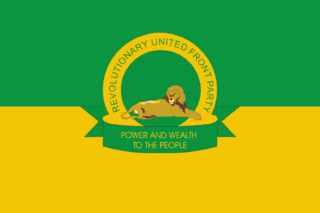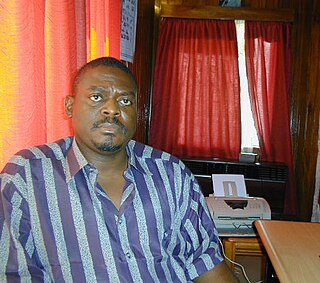Related Research Articles
Sierra Leone first became inhabited by indigenous African peoples at least 2,500 years ago. The Limba were the first tribe known to inhabit Sierra Leone. The dense tropical rainforest partially isolated the region from other West African cultures, and it became a refuge for peoples escaping violence and jihads. Sierra Leone was named by Portuguese explorer Pedro de Sintra, who mapped the region in 1462. The Freetown estuary provided a good natural harbour for ships to shelter and replenish drinking water, and gained more international attention as coastal and trans-Atlantic trade supplanted trans-Saharan trade.

The Revolutionary United Front (RUF) was a rebel group that fought a failed eleven-year war in Sierra Leone, beginning in 1991 and ending in 2002. It later transformed into a political party, which still exists today. The three most senior surviving leaders, Issa Sesay, Morris Kallon and Augustine Gbao, were convicted in February 2009 of war crimes and crimes against humanity.

Alhaji Ahmad Tejan Kabbah was a Sierra Leonean politician who served twice as the 3rd President of Sierra Leone, from 1996 to 1997 and again from 1998 to 2007. An economist and attorney by profession, Kabbah spent many years working for the United Nations Development Programme. He retired from the United Nations and returned to Sierra Leone in 1992.

Major Johnny Paul Koroma was a Sierra Leonean military officer who was the head of state of Sierra Leone from May 1997 to February 1998.

The United Nations Mission in Sierra Leone (UNAMSIL) was a United Nations peacekeeping operation in Sierra Leone from 1999 to 2006. It was created by the United Nations Security Council in October 1999 to help with the implementation of the Lomé Peace Accord, an agreement intended to end the Sierra Leonean civil war. UNAMSIL expanded in size several times in 2000 and 2001. It concluded its mandate at the end of 2005, the Security Council having declared that its mission was complete.
The Armed Forces Revolutionary Council (AFRC) was a group of Sierra Leone soldiers that allied itself with the rebel Revolutionary United Front in the late 1990s. While the AFRC briefly controlled the country in 1998, it was driven from the capital by an international military intervention of the Economic Community of West African States Monitoring Group (ECOMOG). It was no longer a coherent and effective organization by the elections of 2002.
The Sierra Leone Civil War (1991–2002), or the Sierra Leonean Civil War, was a civil war in Sierra Leone that began on 23 March 1991 when the Revolutionary United Front (RUF), with support from the special forces of Liberian dictator Charles Taylor's National Patriotic Front of Liberia (NPFL), intervened in Sierra Leone in an attempt to overthrow the Joseph Momoh government. The resulting civil war lasted 11 years, enveloping the country. It left over 50,000 dead.
Samuel Hinga Norman was a Sierra Leonean politician from the Mende tribe. He was the founder and leader of the Civil Defence Forces, commonly known as the Kamajors. The Kamajors supported the government of Ahmed Tejan Kabbah against the Revolutionary United Front(RUF), which was led by Foday Sankoh. On 7 March 2003 Hinga Norman was indicted by the Special Court for Sierra Leone for war crimes and crimes against humanity. He died on 22 February 2007 in Dakar, Senegal while undergoing medical treatment.
The Lomé Peace Agreement was a peace agreement signed on 7 July 1999 between the warring parties in the civil war that gripped Sierra Leone for almost a decade. President Ahmad Tejan Kabbah signed with the Revolutionary United Front (RUF) leader, Foday Sankoh and granted Sankoh a position in the transitional government as well as amnesty for him and all combatants. The accord is named for Lomé, the capital of Togo, where the negotiations took place and the agreement was signed.
Solomon Anthony James Musa, also known as SAJ Musa, was an important military and political figure in the Sierra Leone Civil War.

The Special Court for Sierra Leone, or the "Special Court" (SCSL), also called the Sierra Leone Tribunal, was a judicial body set up by the government of Sierra Leone and the United Nations to "prosecute persons who bear the greatest responsibility for serious violations of international humanitarian law and Sierra Leonean law" committed in Sierra Leone after 30 November 1996 and during the Sierra Leone Civil War. The court's working language was English. The court listed offices in Freetown, The Hague, and New York City.
Allieu Kondewa is a former traditional doctor in the Kamajors tribe and military commander of the Civil Defence Forces in Sierra Leone. He was born in the Bo District and lived served until his arrest and subsequent trial by the Special Court for Sierra Leone.
Moinina Fofana is a Sierra Leonean former military commander who was the leading general in the Kamajors militia and director of the Civil Defence Forces (CDF) during the Sierra Leone Civil War. He was considered to be one of the leaders of the CDF, like Samuel Hinga Norman and Allieu Kondewa.
The Civil Defense Forces (CDF) was a paramilitary organization that fought in the Sierra Leone Civil War (1991–2002). It supported the elected government of Ahmed Tejan Kabbah against the rebel groups Revolutionary United Front (RUF) and Armed Forces Revolutionary Council (AFRC). Much of the CDF was made up of the Kamajors group, which is part of the larger Mende ethnic group. The Kamajors believed in many magical ways of defending themselves, such as rituals to create bulletproof skin.
Winstanley Bankole Johnson is a Sierra Leonean politician who served as mayor of Freetown from July 2004 until he was ousted by the Freetown City Council on January 17, 2008 after several highly publicised controversies with the previous SLPP regime. Johnson was appointed mayor in July 2004 as a member of the opposition All Peoples Congress. Johnson came to power as the APC swept 2004 municipal elections.
The following list is of events that happened during 2007 in Sierra Leone.

Abdul Aziz One Mohammed was military governor of Borno State, Nigeria, and later was leader of the ECOMOG peacekeeping force in Liberia and Sierra Leone.
Jawei Chiefdom is a chiefdom in Kailahun District of Sierra Leone with a population of 42,635. Its largest town and headquarters is Daru.

The United Nations Observer Mission in Sierra Leone (UNOMSIL) was a United Nations peacekeeping operation in Sierra Leone from 1998 to 1999 that was established with the passage of United Nations Security Council Resolution 1181. Its mission was to monitor the military and security situation in Sierra Leone. The mission was terminated in October 1999, when the Security Council authorized deployment of a new, and significantly larger peacekeeping operation, the United Nations Mission in Sierra Leone (UNAMSIL).
References
- ↑ "Sierra Leone: Kamajors returning to their home areas". The New Humanitarian. July 28, 1999. Archived from the original on April 17, 2023.
- 1 2 3 Kamajors/C.D.F. movement, Sierra Leone (Archive)
- ↑ Dalby, Ned (March 7, 2017). "In Search of the Kamajors, Sierra Leone's Civilian Counter-insurgents". International Crisis Group. Archived from the original on March 29, 2023.
- ↑ Okano, Hideyuki (2019). Politics of Human Network in African Conflicts: Kamajor/the CDF in Sierra Leone. ISBN 9956550183.
- ↑ Robert, Patrick (2001). "Sierra Leone : The Kamajors' last offensive". Visa Pour L'Image. Archived from the original on December 17, 2021.
- ↑ "FORGOTTEN CHILDREN OF WAR IX: CHILD SOLDIERS". Human Rights Watch. 1999. Archived from the original on December 11, 2021.